In a recent article published in the Trends in Endocrinology & Metabolism Journal, researchers summarized studies on the association between high-density lipoprotein cholesterol (HDLC) and different types of cancer to understand whether it is feasible to use plasma HDLC levels as a biomarker and prognostic predictor for cancer.
The study findings could inform research strategies exploring new cancer therapeutics.

Study: High-density lipoprotein cholesterol and carcinogenesis. Image Credit: nobeastsofierce/Shutterstock.com
Background
HDLs are small molecules of high-density proteins and lipids with three main functions in the human body. First, they reverse transport cholesterol from the peripheral blood to the liver for processing and utilization, thereby reducing its accumulation in the body.
Second, HDL has antioxidant activity, with apolipoprotein AI (APOAI) and paraoxonase 1 (PON1) being its main antioxidant components. Lastly, in clinical practice, HDLC levels help monitor cardiovascular disease (CVDs) risk. Strikingly, a recent study showed a U-shaped correlation between HDLC levels and subsequent CVD-related mortality.
Researchers have found a close association of HDLC with tumors, but the mechanism governing the same remains largely unknown. Several previous studies have also consistently found an association between many types of cancers with low HDLC levels in the blood compared to non-cancer patients.
Given the conflicting relationship between HDLC and tumors, further exploration is crucial to strengthen the finding that reduced HDLC levels raise cancer risk and govern poor prognosis of cancer. However, the overall evidence on the molecular mechanisms governing all HDLC function(s) is limited.
Key review findings
Mechanisms linking HDLC and carcinogenesis are not well understood. Studies have evidenced that the relationship between HDLC and breast cancer is highly controversial. Conversely, the relationship between HDLC and ovarian and endometrial cancers is consistent.
Some studies evaluating the correlation between HDLC and ovarian cancer have demonstrated that its levels are markedly low in patients with metastatic gynecological tumors compared to those with benign tumors.
Remarkably, Yilmaz et al. made some contradictory findings in cases of prostate cancer. They suggested that HDLC increased cell proliferation and migration in prostate cancer tumors, likely related to PON1 deficits or reduced scavenger receptor, class B type 1 (SR-B1) expression.
Thus, more studies are needed to confirm the correlation between prostate cancer and HDLC and elucidate whether these differences reflect the unique molecular-level metabolic mechanisms governing prostate cancer.
Xu et al. also found that overexpression of SR-B1 could promote the advancement of clear cell renal cell carcinoma (ccRCC) by extracting cholesterol from HDL into tumor cells, which require nutrition for growth, making it a potential ccRCC biomarker and therapeutic target.
Similarly, the downregulation of liver X receptor (LXR) downregulates the expression of ATP-binding cassette (ABC) transporters mediating cholesterol efflux from cells, thereby inhibiting mitochondria-triggered apoptosis, permitting the survival of cancer cells. Researchers have made similar observations in other cancers.
Another study demonstrated that an SR-B1 inhibitor ceased the proliferation of breast cancer cell lines. In studies on prostate cancer patients, SR-B1 knockout appeared to be related to higher HDLC levels and reduced tumor size substantially.
One more key highlight of this review was the finding that recombinant high-density lipoprotein (rHDL) nanoparticles are a promising novel cancer therapeutic, especially for metastatic cancers. These agents are also highly safe, specifically bind to SR-B1, and remain unrecognized by the reticuloendothelial system.
They showed the potential to successfully deliver small-molecular drugs, therapeutic proteins, vaccine antigens, and even small interfering ribonucleic acid (siRNA). Similarly, rHDL-carrying gambogian could help treat liver cancer by interacting with tumor cells via the SR-B1 receptor.
In triple-negative breast cancer treatment, rHDL combined with lapatinib and valrubicin had a better effect than single-agent treatment. Other applications of rHDL include using rHDLs to encapsulate intratumoral delivery of chemotherapeutic agents to treat colorectal cancer and improve survival rates, as shown in a study by Scheetz et al.
Indeed, the combination of SR-B1 and rHDL has become a significant research area and holds great promise over the coming years.
Conclusions
Most published literature on HDLC and different types of cancers reported that low HDLC levels were related to higher tumor frequency and poor prognosis. However, some studies fetched opposite and non-significant results.
Thus, there is a need for more studies on the mechanisms of HDLC and tumor development to find reliable evidence on the use of plasma HDLC levels as potential markers and prognostic cancer predictors.